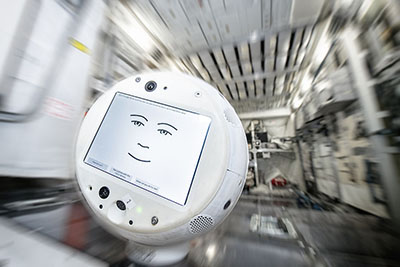IBM Watson
AI-Powered Astronaut Assistant Returns to Space with “Emotional Intelligence”
 |
CIMON, the world’s first AI-powered astronaut assistant |
By John Foley
CIMON, the world’s first AI-powered astronaut assistant, returned to the International Space Station—this time with a heightened ability to analyze human emotion.
The objective, according to the researchers who fine-tuned the robot after its first successful mission aboard the spacecraft, is to transform CIMON from a scientific assistant into “an empathetic companion.”
As was the original CIMON, which spent 14 months in space, the new and improved CIMON-2 is a joint project by IBM, Airbus and the German Aerospace Center (DLR).
CIMON-1 returned to Earth from the International Space Station (ISS) in August. CIMON-2 is heading back to the space station on a SpaceX rocket that launched Dec. 4 from Kennedy Space Center in Cape Canaveral, Florida.
CIMON, which stands for Crew Interactive Mobile Companion, was developed to help astronauts with their many tasks and research activities. The voice-controlled floating robot, which operates with a slight smile on its screen face, can display instructions and record images during an experiment. It can read from manuals and give conversational responses.
About the size of a medicine ball, CIMON made its debut on the ISS in November 2018, responding to a command from German ESA astronaut Alexander Gerst by saying, “What can I do for you?” CIMON-1 assisted with a student experiment on crystallization, demonstrated its ability to maneuver within the ISS’s Columbus research module, and recorded video and images.
CIMON-2 includes more sensitive microphones, more robust computers, and IBM Watson Tone Analyzer technology, which uses linguistic analysis to detect emotion from the tone of a conversation. As with the original CIMON, CIMON-2 will use a dozen internal rotors to maneuver weightlessly, nod or shake its head when listening, and follow an astronaut autonomously or on command.
Equipped with ultrasonic sensors, CIMON-2 has also been engineered for improved orientation within the tight quarters of the ISS.
Reacting to Emotions
In the same way its predecessor did, CIMON-2 uses cameras, microphones, and a speaker to see, hear and speak. When CIMON-1 was first used at the ISS, “it proved it could understand not only the content within its given context, but also the intention behind it, using IBM Watson,” says Matthias Biniok, IBM project manager, Watson AI.
CIMON-2 goes a step further with its ability to evaluate emotions—what Biniok calls emotional intelligence. In the future, CIMON will also empathically respond to situations as appropriate based on its analysis.
The Watson Tone Analyzer, which is delivered from the IBM Cloud, can assess an astronaut’s emotions. For example, if CIMON-2 were to sense that an astronaut is challenged by a task, it could offer assistance or encouragement. This is the same Watson technology used by businesses in customer service centers to automate interactions and in chatbots to detect a customer’s tone during the back and forth of an automated dialog.
CIMON-2 incorporates other AI technologies, including IBM Watson Assistant, which gives the airborne unit its conversational capabilities, and Watson Speech to Text services, for speech recognition and text transcription.
CIMON-2 is also a better listener. New microphones make the device more sensitive to comments and voice commands.
Future Scenarios
CIMON-2 has an extended lifespan. “It is planned that CIMON-2 will stay on the ISS for up to three years and support the crew,” explains Till Eisenberg, CIMON project manager at Airbus.
Beyond that, the research team is looking ahead to future scenarios. One possibility would be to upload AI into an “ISS cloud” for use in space travel. “On a journey to the Moon or Mars, the crew would be able to rely on an AI-based assistance service, without a permanent data link to Earth,” says Christian Karrasch, CIMON project manager with DLR.
The possibilities, as with space travel itself, are endless.